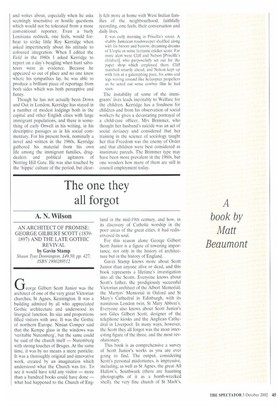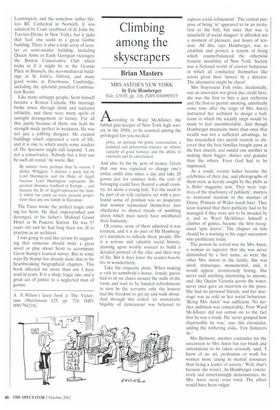The one they all forgot
A. N. Wilson AN ARCHITECT OF PROMISE: GEORGE GILBERT SCOTT (18391897) AND THE LATE GOTHIC REVIVAL by Gavin Stamp Shaun Tyas Donnington, £49.50, pp. 427, ISBN 1900289512 George Gilbert Scott Junior was the architect of one of the very great Victorian churches, St Agnes, Kennington. It was a building admired by all who appreciated Gothic architecture and understood its liturgical function, Its size and proportions filled visitors with awe, It was the Gothic of northern Europe, Ninian Comper said that the Kempe glass in the windows was 'veritable Nuremberg', but the same could be said of the church itself — Nuremberg with strong touches of Bruges. At the same time, it was by no means a mere pastiche. It was a thoroughly original and innovative work, created by an imagination which understood what the Church was for. To see it would have told any visitor — more than a hundred books could have done — what had happened to the Church of Eng
land in the mid-19th century, and how, in its discovery of Catholic worship in the poor areas of the great cities, it had rediscovered its soul.
For this reason alone George Gilbert Scott Junior is a figure of towering importance, not only in the history of architecture but in the history of England.
Gavin Stamp knows more about Scott Junior than anyone alive or dead, and this book represents a lifetime's investigation into all the Scotts, Everyone knows about Scott's father, the prodigiously successful Victorian architect of the Albert Memorial, the Martyrs' Memorial in Oxford and St Mary's Cathedral in Edinburgh, with its numinous London twin, St Mary Abbott's. Everyone also knows about Scott Junior's son Giles Gilbert Scott, designer of the telephone kiosks and the Anglican Cathedral in Liverpool. In many ways, however, the Scott they all forgot was the most interesting figure of the three, and the most revolutionary.
This book is as comprehensive a survey of Scott Junior's works as you are ever going to find. The output, considering Scott's personal misfortunes, is impressive, including, as well as St Agnes, the great All Hallow's. Southwark (there are haunting photographs of it as a bomb-wrecked shell), the very fine church of St Mark's, Leamington, and the somehow rather lifeless RC Cathedral in Norwich. It was admired by Cram (architect of St John the Too-too-Divine in New York), but it lacks that 'feel' one seeks in a great Gothic building. There is also a wide array of secular or semi-secular building, including Queen Anne or Early Georgian vicarages; the Boston Conservative Club which looks as if it might be in the Grande Place in Brussels, the neo-mediaeval buildings at St John's, Oxford, and many good works at Peterhouse, Cambridge, including the splendid panelled Combination Room.
Like many unhappy people, Scott himself became a Roman Catholic. His marriage broke down, through drink and repeated infidelity, and there were many spells of outright derangement or lunacy. For all this, partly because of them, one feels his strength made perfect in weakness. He was not just a jobbing designer. He created buildings which expressed a view of life, and it is one to which surely some readers of The Spectator might still respond. I am not a conservative. Nobody but a fool can be such all round,' he wrote. But
By instinct more perhaps than by reason. I dislike Whiggery. I distrust a party led by Lord Hartington and the Duke of Argyll because Lord Hartington represents the greatest absentee landlord in Europe ... and because the D. of Argyll represents the family which has eaten up more peasant proprietors than any one family in Xtendom.
The Fates wrote the perfect tragic ending for Scott. He died, impoverished and deranged, in his father's Midland Grand Hotel at St Pancras Station. He was 57 years old and he had long been too ill to practise as an architect.
I was going to end this review by suggesting that someone should write a great novel or play about Scott to accompany Gavin Stamp's learned survey. But in some ways Dr Stamp has already done that in his heartbreaking biographical chapters. This book affected me more than any I have read in years. It is a deep, tragic tale, and a great act of justice to a neglected man of genius.
A. N. Wilson's latest book is The Victorians (Hutchinson £25, pp. 724, ISBN 0091794218).





































































 Previous page
Previous page